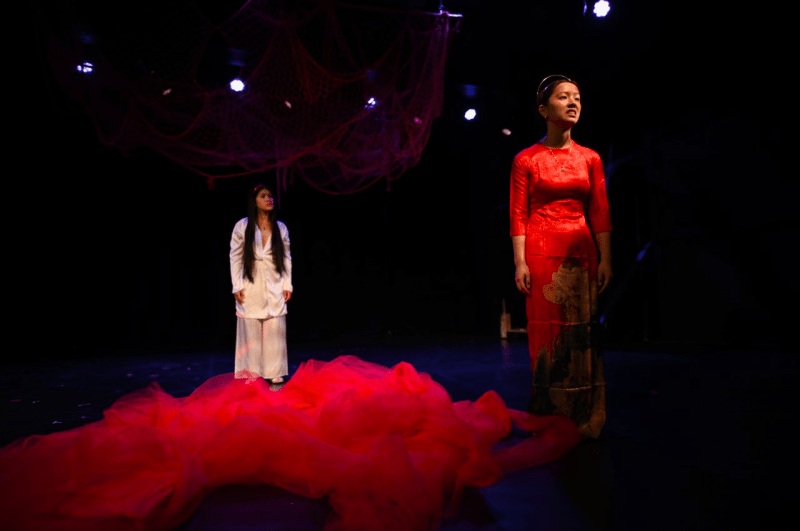“After all I have been through in this life, I don’t think God would punish me for being gay after I die,” Joy (Gwen Le ’23) said, inspiring a chorus of snaps and claps in the black-box theater. A fearless perspective on queerness, her comment encapsulates the central theme of the show: the arbitrary and equalizing nature of birth and death.
Such was how the Asian American Theater Project’s spring mainstage production “Mary Magdalene, Daughter, Boatperson,” written by IDA fellow Diana Khong ’22, won limitless acclaim from the audience during its run in the Nitery Theater last week. With spectacular visual displays, the rendition of talented actors and the creation of an intimate community, the play explores the oft-overlooked themes of Asian American family dynamics in a way that is relatable regardless of one’s background.
“Mary Magdalene” follows how the death of a Vietnamese immigrant mother drags her three children into an inevitable identity quest. The oldest, Mercy (Serena Tran ’25), intersperses reflections on her and her mother’s bumpy relationship with binge-watching TV and stuffing her stomach with fast food; Jimmy (Bea Phi ’24), the “mama’s boy,” turns to video games, troubled by his mother’s expectation of his marrying a girl and starting a big, traditional family. Joy, the youngest yet most responsible of the three, is the only one not in denial; she is haunted by the guilt of not giving her mother a burial according to her wishes and the solitude in executing the funeral ceremony, navigating personal loss without support from her troubled siblings. After a series of trials and tribulations, the three siblings eventually emerge from grief stronger than ever, with Jimmy accepting his queerness and Mercy and Joy likewise determined to put their past in the past and embrace the future together.
The production struck me with its uniquely welcoming and free environment. Introducing the play, Khong, the playwright and director, encouraged the audience to discard the “notoriously white discipline” of reserved formality in theater productions. They urged the audience to “be loud and unafraid,” making theater a novel, interactive experience akin to a drag show.
Inspired by Khong’s comment, the audience cheered Jimmy on as he kissed his best friend, Six (Phong Nguyen ’25), roared with laughter at Mercy and Joy’s sisterly banter and even clapped to encourage the run crew when, during a brief change of scene, a drying rack accidentally fell to the floor. In the intimate black-box setting, the free flow of energy created a supportive community in which we amplified each other’s voices.
Regardless, I found myself laughing uncontrollably at Junah Jang’s ’24 and Dyllen Nellis’s ’24 masterful portrayals in their chorus roles of the many faces of older Asian women. The way they love yet mercilessly roast and beat the other in games reminded me dearly of my elders back home. The audience walked away with murmurs of praise, which might be attributed to the play’s exploration of relatable themes — mother-daughter relationships, cultural heritage and sexuality — in a way that is centered around the tangible struggles of young adults nowadays.
Undeniably, the play was a feast for the eyes, with visual designs (lighting designed by Julie Keipp ’23) and the actors’ talents taking center stage. The set, designed by Ashley Toribio ’22, Christina Shen ’23, Michelle Cai ’23 and Lisa Li ’25, portrayed each of the character’s living spaces with great simplicity yet domestic warmth, most notably visible in Mercy’s stuffed-animal-adorned bed and Ms. Chu’s (Junah Jang ’24) wall filled with Lunar New Year decorations.
I was most impressed by the interplay between the costumes (designed by Dana Chiueh ’23 and Angie Casarez ’23), the set and the plot at the beginning of the second act. The mother (Alexandra Huynh ’25) donned a bright-red áo dài and stands in a pile of red fabric, representing the location of her meeting with her daughter: hell. The color echoed that of a large net in the shape of a boat hanging above their heads, reminding the audience that the journey to the afterlife is a process of migration to a new beginning, similar to the uncertain journey from Vietnam to the United States.
The fiery setting’s reference to hell, however, is largely ambiguous, as it is not clearly cemented by plot development and dialogue. Additionally, the theme of immigration is mentioned only in two old ladies’ jokes about American food being “white people trash.” The theme, while prominent throughout the play, never hit home in a way that was satisfying to me.
Overall, “Mary Magdalene, Daughter, Boatperson” built incredible communities and left the audience with deep reflections amid Asian American Pacific Islander heritage month. Whether we have a family history of immigration or simply have experience moving from our childhood hometown to a big city, the play resonated with our experience of navigating a complex, unjust world in which we have to reconcile our new identities with our parents’ experiences and values.
Editor’s Note: This article is a review and includes subjective opinions, thoughts and critiques.
A previous version of this article included multiple inaccuracies and copy issues, including incorrect pronouns and acknowledgments. The Daily regrets these errors.
